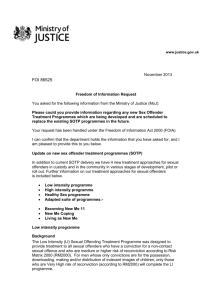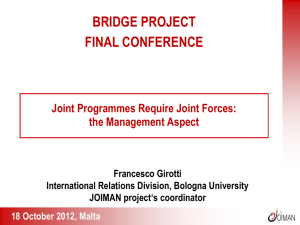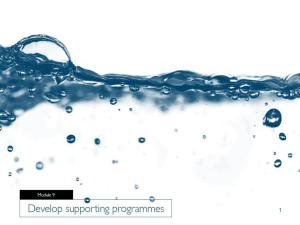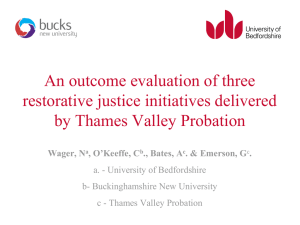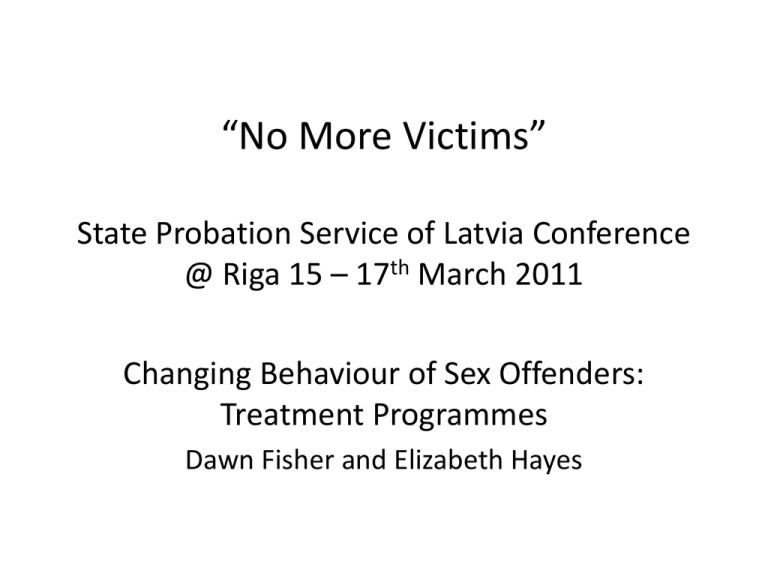
“No More Victims”
State Probation Service of Latvia Conference
@ Riga 15 – 17th March 2011
Changing Behaviour of Sex Offenders:
Treatment Programmes
Dawn Fisher and Elizabeth Hayes
Summary
• Importance of programmes in Criminal Justice
provision
• What works - principles underlying effective
programmes
• Programmes overview
• Interaction between custody and community
treatment settings
• New treatment approaches
Sex Offenders in the Criminal Justice
System
• Significant percentage of offenders i.e. 80,000 prisoners in
English & Welsh prison system of which 6,000 are sexual
offenders (13%)
• Registered sex offenders in 2005/6 was 58 per 100,000 of the
population in England Wales
• Reconviction rates vary according to type of offence and level
of risk deviancy i.e. RM2000:
• Risk category –Very high – 60%
High
- 40.5%
Medium - 18.1%
Low
- 8%
Dynamic Risk Domains
Sexual Interests
Sexual preoccupation
Sexual preference for children
Other offence related sexual
Interests
Offence Supportive Attitudes
Adversarial sexual beliefs
Sexual entitlement beliefs
Child abuse supportive beliefs
Relationships
Inadequacy
Distorted intimacy balance
Grievance thinking
Lack of emotional intimacy
with adults
Self Management
Lifestyle impulsiveness
Poor problem solving
Poor management of
emotions
Importance of treatment in Criminal
Justice systems
• Public protection and risk management
• Reducing the occurrence, severity and
frequency of sexual offending
• Rehabilitation
• Restorative justice
CJS Strategy in England & Wales
• Prison and probation treatment programmes
from 1990s onwards
• Advisory panel - later became accreditation
panel
• Influence of ‘what works’ literature – 1998 –
‘what works for probation’
Accreditation Criteria
•
•
•
•
•
•
•
•
•
•
A Clear Model of Change
Selection of Offenders
Targeting a Range of Dynamic Risk Factors
Effective Methods
Skills Oriented
Sequencing Intensity and Duration
Engagement and Motivation
Continuity of Programmes and Services
Maintaining Integrity
Ongoing Evaluation
Underlying principles - What Works
Meta analysis (Hanson2002, Losel & Schmucker
2005, 2010)
•
•
•
•
•
•
•
Risk-Need-Responsivity
Cognitive Behavioural and Social Learning Theory
Skills based - generalisation and maintenance
Manualised
Trained and supported staff
Quality assured
Evaluated and monitored
Risk Principle – who to treat?
• Sexual offending treatment is prioritised for those
who are at higher risk of re-offending.
• The higher the risk, the greater the ‘dose’ of
treatment.
• Programmes have the most impact on high risk
offenders and least impact on low risk offenders.
Need Principle – what to treat?
• Treatment should focus on issues that that
have been shown to raise risk of future
offending.
• These are called Dynamic Risk Factors or
Criminogenic Needs, i.e. significant causal
factors.
Responsivity Principle – how to treat?
• Structured, cognitive behavioural approach with strong
emphasis on collaborative enquiry and active skill-building.
• Motivational, conveying hope for the future. Emphasis on a
constructive approach to future, rather than creating
stigmatising shame about the past.
• Warm, empathic, reinforcing and directive therapist style.
• Adaptations for special needs, e.g. intellectual disabilities,
personality disorders, mental health issues.
• Purposeful eclecticism, adapting and using methods and
techniques as appropriate to the offender and his learning
style. ‘Finding the shoe that fits.’
Treatment Methods
Principally CBT plus elements of Social
Learning Theory
•
•
•
•
•
Self-analysis and cognitive restructuring
Modelling of alternative thinking/behaviour
Implementation of alternative thinking/behaviour
Modeling of anti-criminal attitudes/behaviours
Skills development
Factors Targeted in Treatment Programmes
• Cognitive support for offending
• Deviant sexual interests, arousal patterns, sexual
preoccupation
• Difficulty in recognising personally relevant risk
factors
• Difficulty in generating or enacting appropriate
coping strategies
• Deficits in interpersonal, self-management or
problem solving skills to cope with personally
relevant risk factors
• Social support for sexual offending
Acquisition of Skills to Deal With:
• Inappropriate sexual preferences
• Offence supportive attitudes
• Overcoming intimacy deficits i.e. elevated
emotional loneliness; relationship skills;
insecure attachments
• Management of emotions
• Sexual preoccupation (to reduce where
preoccupation sustains the offending)
• Maintaining change
Successfully delivered programmes require
• Skilled and enthusiastic group facilitators
• Good communication - case managers and programme
facilitators
• Committed case management
• Effective PSR authors
• Good communication - workers and supervisors
• Quality Control and Quality Assurance issues addressed
• Programme providers supported
• Programmes monitored and evaluated
• Quality Control and Quality Assurance issues addressed
• Programmes integrated within overall Probation
supervision activity
Therapist behaviors that enhance
treatment effectiveness
• Empathic, genuine, warm, respectful,
supportive, self disclosing
• Asks open ended questions, directive, flexible,
encourages participation, rewarding, use of
humor
• Attentive, confident, trustworthy, instills
positive expectations, emotionally responsive
Therapist behaviors that reduce
treatment effectiveness
• Aggressive confrontation, rejection,
manipulation of patient, low interest,
critical, sarcastic, hostile/angry
• Discomfort with silences, unresponsive,
dishonest, judgmental, authoritarian,
defensive
• Need to be liked, nervous, does not wait for
answers, boundary problems, rigidity,
coldness
Range of Programmes
• Prison – CORE 2000, Extended, Adapted,
Rolling Programme, Healthy Sexual
Functioning
• Probation – TVSOG, N-SOG, C-SOG, Internet
programme
• All programmes currently under review
TVSOGP
Statement of Purpose
To reduce risk of re-offending by:
• Targeting offenders based on their risk,
treatment needs and responsivity needs.
• Increasing offenders opportunity of leading a
more fulfilling life, meeting needs by prosocial means.
Model of Change
(based on original concept by Fisher & Beech)
DENIAL
Cognitive Distortions
OFFENCE
SPECIFIC
PROBLEMS
Self esteem
Assertiveness
Intimacy
Sexual Arousal
Lack of Victim Empathy
LEVEL OF
SOCIAL
ADEQUACY
Problem Solving
Self Management
KNOWLEDGE OF
RELAPSE
SUCCESSFUL
TREATMENT
Eligibility
•
•
•
•
•
•
•
•
•
Age = 18+
I.Q. = 80 plus
Mental Health - stabilised 6 months
Substance abuse stabilised
Some acceptance of his conviction
Recognition of need to change behaviour
Willingness to participate in group-work
Language requirement
NB – Literacy deficits do not exclude
The Change Process
Reduction in denial
Cognitive Restructuring
Foundation Block
Taking responsibility for offending
Foundation Block & throughout
programme
Addressing distortions
Pro-offending thinking patterns
Victim empathy Block
Enhancing victim empathy
Addressing deficits in socio-affective
functioning
Addressing problems of self management
Better Lives Relapse Prevention Block
Life Skills, RP & skills rehearsal
Problem Solving, coping, strategies,
relationship skills, conflict resolution
Life Skills & Relapse Prevention
Identify & manage difficult
situations, impulsivity, links to
offence triggers
Develop/practice skills for
positive lifestyle, risk
management, support networks,
keep safe plans
TVSOGP
• Sex offenders are heterogeneous so
programme has to meet individual needs as
far as possible – thus divided into blocks
which can be attended/repeated as required
i.e. offender requiring RP/maintenance can
attend Better lives section
• Pre-post treatment evaluation to identify
treatment needs and evaluate change
Programme Structure
Foundation Block
10 day programme
Monday – Friday 9.30am – 5.00pm x 2 weeks
Total group time = 60 hours
MODULE
CONTENTS
1
Establishing the group
1
2
Link between thoughts, feelings
and behaviours
Sexual thoughts
Finkelhor’s Preconditions
Model
Routes to offending
Deciding to offend
Consequences of offending
Making change possible
Progress review and planning
for the future
2
3
4
5
6
7
8
9
8
8-9
10
25
Victim Empathy Block
Twice Weekly Sessions
8 sessions X 2 hrs,
Follow on from Foundation Block
Total group time =16 hours
SESSIONS
1
2
3
4
5
6
7
8
Introduction to Empathy
Perspective Taking (Letter to Victim)
The extent of victimisation
The effects of sexual abuse
Understanding the victims’ behaviour
Victim perspective role-plays
Victims’ Questions
Letter to victim (not to be sent)
27
Life Skills Block
Twice weekly sessions
20 sessions – 2 hours duration
Total group time = 40 hours
OUTLINE OF LIFE SKILLS BLOCK
SESSIONS 1 - 2
Self Image
SESSIONS 3 - 6
Positive thinking & Problem Solving
SESSIONS 7 - 16
Interpersonal Skills
SESSIONS 17 - 19
Problems arising in intimate relationships
SESSION 20
Bringing it all together
29
Relapse Prevention ‘Better Lives’ Block
One session per week
22 sessions - 2 hours duration
Total group time = 44 hours
NB: if the group is larger than 8 offenders, up to
4 extra sessions will be added
Modules of ‘Better lives’ block
• Familiarisation with the ‘Better Lives’ Model
• Identifying risk factors
• Coping strategies
• Keep-safe Plan & Time Planning
• Guest Speaker
• Development of individual treatment targets
• Skills practice
•
•
•
•
Addressing Dynamic Risk Domains
‘Bringing it all together’
Develop Good Life & Keep-safe Plans
Presentations to Offender Managers, who attend the last
session
31
Substantial Emphasis on Training and
Supervision
(particularly important when moving to scale)
• Staff to demonstrate required competence
prior to acceptance into training
• Training is assessed, staff to demonstrate
required competence on training
• Supervision ongoing for staff skills and
support and to maintain programme integrity
Quality Assurance
Treatment Management
Supervision and video monitoring
To protect
• Programme integrity
To prevent
• Programme drift, reversal, non-compliance
To promote
• Treatment style
Quality Assurance
Audit
• All programmes audited for compliance and
clinical quality
• Programmes designed to have auditable
products
Audit Criteria
Compliance
is the programme being managed properly
is the programme being delivered as designed with
the right length of treatment (dose), frequency,
length of session, size of group, number of facilitators
Clinical audit
looks at the quality of delivery
20 factors, under 4 headings:
adherence to manuals
treatment style
group work delivery skills
responsivity
Evaluation and Monitoring
Psychometrics
• Used to determine treatment needs pretreatment
• Used as a measure of progress post-treatment
• Used to evaluate programmes
Evaluation and Monitoring
Recidivism - reconviction data
• desistance
• frequency
• intensity
Making Changes in Programmes
• Role of TM
– where a change needs planning outside the group
session
• Change Control
– for substantial changes
• Accreditation Panel guidance for the biggest changes
– redesign, replacement programmes
• Revisions + new programmes
New Treatment Approaches - recent
• Reduced focus on denial, offence accounts and ‘cognitive
distortions’
• Reconsideration of ‘victim empathy’
• Increased focus on therapist style – ‘who works’ v ‘what works ‘
• Second generation programmes - increased Individualization within
a standardised approach
• Development of strengths-based approaches i.e. GLM
• Enhanced focus on skills training
• Increased attention to contextual support, ‘wrap-around’ services
New Treatment Approaches - future
• Rethinking victim empathy
• Low risk offenders - less treatment, more
management
• ‘Brain-informed’, reflecting neuro-science
developments
• Incorporate alternative techniques: mindfulness and
self-compassion, non verbal therapies i.e. arts
therapies (music, art, drama)
• Increased application of desistance theories
• Cross-setting versus single strand approaches
Low Risk
•
•
•
•
•
•
Reconviction rate is < 1% over 4 years
Dangers of over-treating
Low risk ≠ no risk
Public expectations + victim’s expectations
Some LRSOs request treatment – ethics?
Exclude LRSOs – message that some sexual
crimes are ‘not serious’
• Risk assessment tools apply to groups not
individuals
• How to assess 10% high risk-low risk
Low Risk
Aims
Motivation
Problem Solving
Resettlement
Risk management – especially acute risk
factors
Improve cooperation with CJ and other
agencies
Challenges for Efficient Programmes
• integrity and innovation
• Supply versus demand – access to treatment timely and
sufficient
• Providing for diversity
• Staying good, getting better – continuous professional
development for treatment staff and organisation
• Adaptation to changing environment – political and
knowledge base
• Targets – inputs, outputs , outcomes
• Case management on board
• Meeting need managing resources – how to respond to
risk and need of those not in treatment
• Managing expectations and aspirations
Custody-Community Treatment
Interaction
Opportunities
Coherence, Continuity, Consistency
Integrated or seamless treatment
‘Through the gate’ provisions
Programmes in institutions and community
combined to enable different doses of
treatment, follow-up, ongoing risk
management
Joint training and delivery
Custody-Community Treatment
Interaction
Challenges
Same tools needed for risk & need assessment
and common outcome measures
Gaps and duplication in provision
Differing emphases eg.
- deniers, refusers
- voluntary versus mandated treatment
- risk management
Culture, Confidence
Contact details
elizabeth.hayes@hacic.co.uk
dfisher@standrew.co.uk


